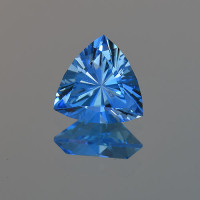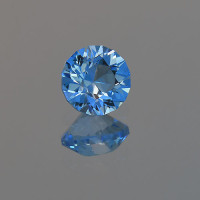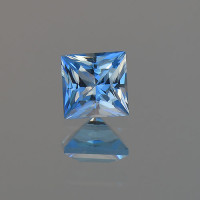Topaz
Topaz
Topaz of any type is a good jewelry stone and it is historically one of the most important gemstones. With its relatively high refractive index and hardness of eight (Mohs scale), with no special sensitivity to chemicals it can be used, with appropriate care (should be protected from hard knocks), in any jewelry application.
Topaz comes in many colors, including clear, brown, yellow, orange, red, pink and blue. The blue topaz, with a pale to medium blue color created by irradiation, can be found in very large sizes at affordable prices. The fine golden-yellow variety, known as Imperial Topaz, is relatively scarce. Topaz colors are rarely vivid. The most common color is yellow with a red tint; the most valuable is pink to reddish. The coloring agents are iron and chromium.
The name topaz is most probably derived from an island in the Red Sea, "Topazos", today called Zabargad, the ancient source of peridot. In former times all golden-brown and sometimes also green gemstones were called topaz, which caused sufficient confusion such that today real topaz is referred to as precious topaz.
Topaz is the birthstone for those who are born in the month of November.
Topaz colors
Topaz comes in many colors, including clear, brown, yellow, orange, red, pink and blue. The blue topaz, with a pale to medium blue color created by irradiation, can be found in very large sizes at affordable prices. The fine golden-yellow variety, known as Imperial Topaz, is relatively scarce. Topaz colors are rarely vivid. The most common color is yellow with a red tint; the most valuable is pink to reddish; the most popular is blue. The coloring agents are iron and chromium.
Blue topaz: Natural blue topaz is rare. Found in all major deposits and also in England (Cornwall), Northern Ireland and Scotland. Most of the blue topazes are enhanced colorless topaz gemstone (see common treatment)
Champagne topaz: One of the very few naturally colored varieties of topaz in a light to medium shade of brown, primarily found in Mexico.
Imperial topaz: The most sought after of all natural topaz. Its rich golden color is generally not enhanced by any kind of treatment. The most important deposit was found in Minas Gerais, Brazil.
Pink topaz: A natural pink topaz is very rare and costly. The vast majority of pink topazes are heat-treated yellow stones that turn pink. The most valuable variety of topaz can be found in Brazil, Pakistan and Russia.
Common Topaz treatments
Blue topaz begins as colorless or very lightly tinted natural topaz crystals, which are then irradiated to change the color to blue and heated to stabilize the change. Neutron bombardment in a nuclear reactor produces the deep slightly greenish or grayish "London Blue", while electron bombardment in a linear accelerator results in the light aqua-like blue known as "Sky Blue". Combinations of both treatments produce the highly saturated "Swiss" and "Electric" blues. If neutron bombardment has been used, there is residual radioactivity, and the gems must be held, up to a year, before they have "cooled" enough to be worn.
In general, blue topaz is modestly priced. Due to the expenses of reactor time the London Blue color is short in supply and climbs in value.
In early 1998, a new type of enhanced topaz made its appearance, the surface-enhanced topaz, with colors described as blue to greenish-blue or emerald green.
The vast majority of pink topazes are heat-treated yellow stones that turn pink.





